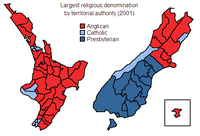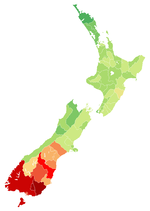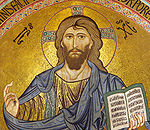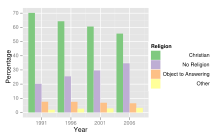- Christianity in New Zealand
-
Christianity by Country
North AmericaSouth AmericaOceaniaChristianity in New Zealand dates to the arrival of missionaries in the early 19th century and is the country's primary religion. Slightly more than half the population identify as Christian. Christian organisations are the leading non-government providers of social services in New Zealand. [1] [2] A number of denominations are present, with none having a dominant position.
Contents
History
The first Christian missionaries came to New Zealand at the start of the 19th century. The Church Mission Society, an Anglican organisation, established a presence in New Zealand in 1814,[3] with the permission and protection of Ngā Puhi chief Ruatara. This expedition was led by Samuel Marsden. Later missionaries brought other religious denominations — Jean Baptiste Pompallier played an important role in establishing Roman Catholicism. Presbyterianism was brought to New Zealand largely by Scottish settlers. The Maori people also created their own forms of Christianity, with Ratana and Ringatu being the largest.
The Sisters of Mercy arrived in Auckland in 1850 and were the first order of religious sisters to come to New Zealand and began work in health care and education.[4] At the direction of Mary MacKillop (St Mary of the Cross), the Sisters of St Joseph of the Sacred Heart arrived in New Zealand and established schools. In 1892, Suzanne Aubert established the Sisters of Compassion - the first Catholic order established in New Zealand for women.[5] The Anglican Church in New Zealand recognises her as a saintly person and in 1997 the New Zealand Catholic Bishops’ Conference agreed to support the “Introduction of the Cause of Suzanne Aubert”, to begin the process of consideration for her canonisation as a saint by the Catholic Church.[6]
Although there was some anti-Catholic feeling in the 19th and early 20th centuries, this declined after the 1920s. Sectarian groups such as the Orange Order continue to exist in New Zealand but are now virtually invisible. New Zealand's first Catholic Prime Minister, Joseph Ward, took office in 1906. The founding of the National Council of Churches(NCC)in 1941 marked the positive relationships between New Zealand Christians. The NCC was an important voice of the churches in national affairs. The NCC was replaced in 1988 by a new ecumenical body which included Roman Catholics -the Conference of Churches in Aotearoa New Zealand (CCANZ). CCANZ closed in 2005. There is now very little sectarianism in New Zealand and various churches commonly co-operate on issues of common interest — various ecumenical bodies exist promoting co-operation between Christians. An ecumenical organisation which includes conservative evangelicals is the Vision Network.,[7] and church leaders have issued joint statements on a number of issues (for example, on the Iraq War[8])
Christian organisations in New Zealand remain heavily involved in community activities including education; health services; chaplaincy to prisons, rest homes and hospitals; social justice and human rights advocacy.[9] Approximately 11% of New Zealand students attend Catholic schools;[10] the Anglican Church in New Zealand administers a number of schools;[11] and schools administered by members of the New Zealand Association for Christian Schools educated 13,000 students in 2009.[12]
Demographics
See also: Religion in New Zealand#DemographicsDenominational affiliation
In the 2006 census, around 55.6% of those who answered the question on religion identified themselves as Christian. This gives a total of slightly more than two million Christians in the country. The largest denominations were Anglicans (about 14% of the population), Catholics (about 12%), Presbyterians (about 9%), and Methodists (about 3%). Around 5% of the population identified themselves as Christian without associating themselves with any particular denomination.[13]
Denominational Affiliation in New Zealand[14] 2006 2001 1996 Number % Number % Number % Anglican 554,925 14.7 584,793 16.7 631,764 18.8 Roman Catholic 508,437 13.4 485,637 13.9 473,112 14.1 Presbyterian, Congregational and Reformed 400,839 10.6 431,139 12.3 470,442 14.0 Christian (not further defined) 186,234 4.9 192,165 5.5 186,891 5.6 Methodist 121,806 3.2 120,546 3.4 121,650 3.6 Pentecostal 79,155 2.1 67,182 1.9 69,333 2.1 Baptist 56,913 1.5 51,423 1.5 53,613 1.6 Latter-day Saints 43,539 1.2 39,915 1.1 41,166 1.2 Brethren 19,617 0.5 20,397 0.6 21,933 0.7 Jehovah's Witness 17,910 0.5 17,829 0.5 19,527 0.6 Adventist 16,191 0.4 14,868 0.4 14,691 0.4 Evangelical/Fundamentalist 13,836 0.4 11,016 0.3 1,584 0.0 Orthodox Christianity 13,194 0.3 9,576 0.3 6,933 0.2 Salvation Army 11,493 0.3 12,618 0.4 14,625 0.4 Other Christian 16,830 0.4 15,513 0.4 16,734 0.5 Total Christian 2,027,418 53.6 2,043,843 58.4 2,143,995 63.8 Ratana 50,565 1.3 48,975 1.4 36,450 1.1 Ringatu 16,419 0.4 15,291 0.4 8,271 0.2 Other Maori Christian 579 0.0 660 0.0 729 0.0 Total Maori Christian 65,550 1.7 63,597 1.8 45,450 1.4 Object to answering 242,610 6.4 239,244 6.8 256,593 7.6 Total population 4,027,947 3,737,277 3,618,303 (Note: All figures are for the census usually resident population.
Percentages are based on number of responses rather than total population.
In the 1996 Census only one response to religious affiliation was collected. In the 2001 and 2006 Censuses up to four responses were collected.)Trends
The proportion of New Zealanders who identify as Christian is declining, the figure now stands at around half the census respondents, whereas in the 1991 census, it stood at around three quarters. Different denominations are experiencing different trends. Anglicanism and Presbyterianism are both losing adherents, while Catholicism is gaining.
Geographic distribution
The number of Christians in New Zealand varies slightly across different parts of the country — as of the 2006 census, the number of Christians in each territorial authority ranged from a low of 43.7% (in Kawerau) to a high of 63.4% (in Ashburton).[15] In general, the tendency is for rural areas, particularly in the lower South Island, to have somewhat higher numbers of Christians, and urban areas to have lower numbers — of the sixteen designated Cities of New Zealand, fifteen have a smaller proportion of Christians than the country as a whole (the exception being Invercargill).[15] The average proportion of Christians in the sixteen cities is 50.2%.[15]
The three largest denominations are found in all parts of the country — the maps below show their distribution across the territorial authorities. No territorial authority has more than a third of its population belonging to a single denomination, although some parts of the lower South Island come close.[15]
Largest denominations (2001) Anglicanism (2006) Catholicism (2006) Presbyterianism (2006) 



- Anglicanism is common in most parts of the country, but is strongest in Canterbury (the city of Christchurch having been founded as an Anglican settlement) and on the North Island's East Coast. It is the largest denomination in most parts of rural New Zealand, the main exception being the lower South Island.
- The territorial authorities with the highest proportion of Anglicans are Gisborne (where they are 27.4% of the total population), Wairoa (27.1%), and Hurunui (24.9%).
- The territorial authorities with the lowest proportion of Anglicans are Invercargill (7.7%), Manukau (8.3%), and Clutha (8.5%).
- Catholicism is the most evenly distributed of the three main denominations, although it still has noticeable strengths in south and central Taranaki, on the West Coast, and in Kaikoura. It is also the largest denomination in Auckland and Wellington, although not by a great extent.
- The territorial authorities with the highest proportion of Catholics are Kaikoura (where they are 18.4% of the total population), Westland (18.3%), and Grey (17.8%).
- The territorial authorities with the lowest proportion of Catholics are Tasman (8.1%), Clutha (8.7%), and Western Bay of Plenty (8.7%).
- Presbyterianism is strong in the lower South Island — the city of Dunedin was founded as a Presbyterian settlement, and many of the early settlers in the region were Scottish Presbyterians. Elsewhere, however, Presbyterians are usually outnumbered by both Anglicans and Catholics, making Presbyterianism the most geographically concentrated of the three main denominations.
- The territorial authorities with the highest proportion of Presbyterians are Gore (where they are 30.9% of the total population), Clutha (30.7%), and Southland (29.8%).
- The territorial authorities with the lowest proportion of Presbyterians are Far North (4.4%), Kaipara (6.2%), and Wellington (6.7%).
Denominations and organisations
Main article: List of Christian organisations in New ZealandCulture and the arts
The Christian festivals of Christmas and Easter are marked by public holidays in New Zealand.[16] Christmas Day, 25 December, falls during the Southern Hemisphere Summer allowing open air caroling and barbecues in the sun. Nevertheless various Northern hemisphere traditions have continued in New Zealand - including roast dinners and Christmas trees, with the pohutukawa regarded as New Zealand’s iconic Christmas tree.[17] [18]
The architectural landscape of New Zealand has been affected by Christianity and the prominence of churches in cities, towns and the countryside attests to its historical importance in New Zealand.[19] Notable Cathedrals include the Anglican Holy Trinity Cathedral, Auckland, Christchurch Cathedral, Christchurch and St Paul's Cathedral, Wellington and the Catholic St Patrick's Cathedral, Auckland, Sacred Heart Cathedral, Wellington, Cathedral of the Blessed Sacrament, Christchurch, St. Joseph's Cathedral, Dunedin. The iconic Futuna Chapel was built as a Wellington retreat center for the Catholic Marist order in 1961. The design by Maori architect John Scott, fuses Modernist and indigenous design principles.
Christian and Maori choral traditions have been blended in New Zealand to produce a distinct contribution to Christian music, including the popular hymns Whakaria Mai and Tama Ngakau Marie[20][21] New Zealand hosts the largest Christian music festival in the Southern Hemisphere, Parachute Music Festival. The festival is also one of the largest music festivals in the Southern Hemisphere overall.
Politics
Main article: Christian politics in New ZealandMost New Zealanders consider politicians' religious beliefs to be a private matter.[22] Both the current Prime Minister John Key and his predecessor Helen Clark are agnostic,[23][24] but the current Deputy Prime Minister Bill English is Roman Catholic.[25] A large number of New Zealand Prime Ministers have been professing Christians, including Jenny Shipley, Jim Bolger, Geoffrey Palmer, David Lange, Robert Muldoon, Walter Nash, Keith Holyoake, and Michael Joseph Savage. Sir Paul Reeves, the Governor General from 1985–1990, was previously Anglican Archbishop and Primate of New Zealand from 1980–85. It has been claimed that Christianity continues to play a 'significant and sometimes controversial role' in the politics of New Zealand.[26][27]
Christian political parties have never gained significant support and have often been characterised by controversy. Many of these are now defunct, such as the Christian Democrat Party, the Christian Heritage Party which collapsed after leader Graham Capill was convicted as a child sex offender,[28] Destiny New Zealand, The Family Party and the New Zealand Pacific Party whose leader Taito Phillip Field was convicted on bribery and corruption charges.[29] United Future, which although not a Christian party, has had significant Christian backing, has been more successful, the two main political parties, Labour and National, are not religious, although religious groups have at times played a significant role (e.g. the Ratana Movement). Politicians are often involved in public dialogue with religious groups.[30][31] The Exclusive Brethren gained public notoriety during the 2005 election for distributing anti-Labour pamphlets, which former National Party leader Don Brash later admitted to knowledge of.[32]
Christianity has never had official status as a national religion in New Zealand and a poll in 2007 found 58 percent of people were opposed to official status being granted.[33]Queen Elizabeth II, although Supreme Governor of the Church of England, exercises this capacity in her role as monarch of Britain, not her constitutionally separate role as monarch of New Zealand. The Anglican Church in New Zealand (today a separate institution from its parent) is not an officially established church, although it often officiates at civic events such as Anzac day.
Controversy
Presbyterian minister and theologian Lloyd Geering was the subject of one of the few heresy trials of the 20th century in 1967, with a judgement that no doctrinal error had been proved. The Catholic Church in New Zealand had a number of its priests convicted of child sexual abuse, notably at Marylands School. Newspapers have also reported child sex abuse cases within the Exclusive Brethren.[34]
See also
- List of Christian organisations in New Zealand
- Religion in New Zealand
- Christian politics in New Zealand
- National Statement on Religious Diversity
References
- ^ New Zealand Herald (4 April 2008). "Church actions louder than words.". http://www.nzherald.co.nz/christianity/news/article.cfm?c_id=500818&objectid=10501913.
- ^ "Facts about the sub-sectors of the community sector". OCVS website. Office for the Community and Voluntary Sector. http://www.ocvs.govt.nz/work-programme/building-knowledge/subsector-facts.html. Retrieved 25 May 2010.
- ^ "MARSDEN, Samuel". Encyclopedia of New Zealand. Ministry for Culture and Heritage. 1966. http://www.teara.govt.nz/1966/M/MarsdenSamuel/MarsdenSamuel/en. Retrieved 3 June 2010.
- ^ "Who We Are > History - General". Sisters of Mercy. http://www.sistersofmercy.org.nz/who/default.cfm?loadref=7. Retrieved 3 June 2010.
- ^ "Who We Are > The Journey". Sisters of Saint Joseph. http://sistersofsaintjoseph.org.nz/the-journey. Retrieved 3 June 2010.
- ^ "The Process of Beatification and Canonisation: The making of a New Zealand Saint". Sisters of Compassion. http://www.hoc.org.nz/aubert/canonisation.htm. Retrieved 3 June 2010.
- ^ "Vision Network New Zealand Website". Vision Network. http://www.vision.org.nz/. Retrieved 3 June 2010.
- ^ Paterson, John. et. al. (9 February 2009). "There is still time". World Alliance of Reformed Churches. http://www.warc.ch/dcw/iraq/05.html. Retrieved 3 June 2010.
- ^ "The Works of Mercy". Sisters of Mercy. http://www.sistersofmercy.org.nz/who/default.cfm?loadref=8. Retrieved 3 June 2010.
- ^ "Catholic Schools - Today". Catholic Education Office Ltd. http://www.nzceo.catholic.org.nz/pages/schools/schools-today.html. Retrieved 3 June 2010.
- ^ "Schools". Anglican Schools Office. http://www.anglicannzschools.org/schools/. Retrieved 3 June 2010.
- ^ "A Brief Summary of the History of Christian Schooling in New Zealand". New Zealand Association for Christian Schools. 1 January 2009. http://www.nzchristianschools.org/index.php?option=com_content&task=view&id=60&Itemid=94. Retrieved 3 June 2010.
- ^ "2006 Census Data > QuickStats About Culture and Identity - Religious Affiliation". Statistics New Zealand. http://www.stats.govt.nz/Census/2006CensusHomePage/QuickStats/quickstats-about-a-subject/culture-and-identity/religious-affiliation.aspx. Retrieved 30 May 2010.
- ^ "Table 25 in 2006 Census Data > QuickStats About Culture and Identity - Tables". Statistics New Zealand. http://www.stats.govt.nz/Census/2006CensusHomePage/classification-counts-tables/about-people/religious-affiliation.aspx. Retrieved 14 Nov 2011.
- ^ a b c d "Table Builder". Statistics New Zealand. Archived from the original on 15 April 2008. http://web.archive.org/web/20080415080504/http://www.stats.govt.nz/products-and-services/table-builder/default.htm. Retrieved 3 May 2008.
- ^ "Public Holidays". Department of Labour. http://www.ers.dol.govt.nz/holidays_act_2003/public_holidays.html.
- ^ "Kiwi Christmas". New Zealand History Online. Ministry of Culture and Heritage. 22 February 2010. http://www.nzhistory.net.nz/culture/kiwi-xmas. Retrieved 3 June 2010.
- ^ "Kiwi's attitude to Christmas". New Zealand History Online. Ministry of Culture and Heritage. 16 December 2009. http://www.nzhistory.net.nz/media/video/kiwis-attitude-to-christmas. Retrieved 3 June 2010.
- ^ John Wilson (3 March 2009). "Society - Religion and the churches". Te Ara - the Encyclopedia of New Zealand. Ministry of Culture and Heritage. http://www.teara.govt.nz/en/society/7. Retrieved 3 June 2010.
- ^ "Whakaria Mai". Folksong.org.nz. http://folksong.org.nz/whakaaria/index.html.
- ^ "The Battalion Sings 'Tama Ngakau Marie'". 28th Maori Battalion. Ministry of Culture and Heritage. 3 March 2009. http://www.28maoribattalion.org.nz/audio/the-battalion-sings-tama-ngakau-marie. Retrieved 3 June 2010.
- ^ Brian Colless and Peter Donovan, 'Editor's Introduction', in Brian Colless and Peter Donovan, eds, Religion in New Zealand Society, 2nd edition, Palmerston North: Dunmore Press, 1985, p.10
- ^ NZPA (5 November 2008). "Clark and Key spar in final TV debate before election". http://www.3news.co.nz/Clark-and-Key-spar-in-final-TV-debate-before-election/tabid/209/articleID/78661/Default.aspx. Retrieved 2010-06-15.
- ^ New Zealand Herald (16 March 2004). "Insults get personal between Clark and Brash". http://www.nzherald.co.nz/section/story.cfm?c_id=1&objectid=3554978. Retrieved 2007-07-08.
- ^ Church has vital place in our secular society, Challenge Weekly 66 (6), 2008-02-25, archived from the original on 2008-03-04, http://web.archive.org/web/20080304144442/http://www.challengeweekly.co.nz/story3.htm, retrieved 2009-10-01
- ^ Rex Ahdar & John Stenhouse (2000). God and Government. Dunedin: University of Otago Press. p. 9.
- ^ "God and Government", University of Otago Press
- ^ "Capill sentenced to nine years for child sex crimes". The New Zealand Herald. 14 July 2005. http://www.nzherald.co.nz/nz/news/article.cfm?c_id=1&objectid=10335782. Retrieved 2010-06-14.
- ^ "Guilty verdicts for Taito Phillip Field". The New Zealand Herald. 4 August 2009. http://www.nzherald.co.nz/nz/news/article.cfm?c_id=1&objectid=10587391. Retrieved 11 August 2009.
- ^ "Even politicians are popular at huge Christian music fest". New Zealand Herald. 29 January 2007. http://www.nzherald.co.nz/parachute-music-festival/news/article.cfm?c_id=1500869&objectid=10421364.
- ^ "Hindu group accused of 'hijacking' other faiths". New Zealand Herald. 2010-05-03. http://www.nzherald.co.nz/nz/news/article.cfm?c_id=1&objectid=10642345. Retrieved 2010-10-01.
- ^ NZPA (2005-09-08). "Brash knew about Exclusive Brethren pamphlets". New Zealand Herald. http://www.nzherald.co.nz/nz/news/article.cfm?c_id=1&objectid=10344635. Retrieved 2010-06-15.
- ^ "Majority reject state religion: poll". The New Zealand Herald. 17 June 2007. http://www.nzherald.co.nz/section/1/story.cfm?c_id=1&objectid=10446229. Retrieved 24 September 2011.
- ^ Hubbard, Anthony (18 October 2009). "'Plague' of sex abuse in church alleged". The Sunday Star-Times. http://www.stuff.co.nz/national/crime/2975741/Plague-of-sex-abuse-in-church-alleged. Retrieved 24 September 2011.
Further reading
- Hoverd, William James (2008). "No Longer a Christian Country? - Religious Demographic Change in New Zealand 1966–2006". New Zealand Sociology (Royal Society of New Zealand) 23 (1). http://www.ipp.org.nz/essudocs/sociology/nz233final.pdf.
- Davidson, Allan K. (2004). Christianity in Aotearoa : a history of church and society in New Zealand (3rd ed.). Wellington: Education For Ministry. ISBN 047600229X.
- Lineham, Peter J. (1989). Transplanted Christianity: Documents Illustrating Aspects of New Zealand Church History (2nd ed.). Palmerston North: Dunmore Press.
- Ahdar, Rex (2003). God and Government: The New Zealand Experience. Dunedin: University of Otago Press.
Christianity in Oceania Sovereign states Dependencies and
other territories- American Samoa
- Christmas Island
- Cocos (Keeling) Islands
- Cook Islands
- Easter Island
- French Polynesia
- Guam
- Hawaii
- New Caledonia
- Niue
- Norfolk Island
- Northern Mariana Islands
- Pitcairn Islands
- Tokelau
- Wallis and Futuna
Categories: - Anglicanism is common in most parts of the country, but is strongest in Canterbury (the city of Christchurch having been founded as an Anglican settlement) and on the North Island's East Coast. It is the largest denomination in most parts of rural New Zealand, the main exception being the lower South Island.
Wikimedia Foundation. 2010.


